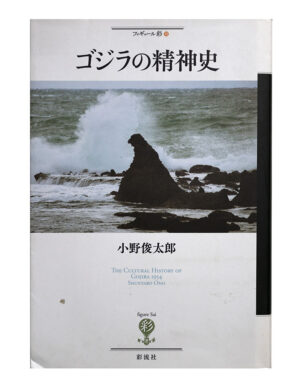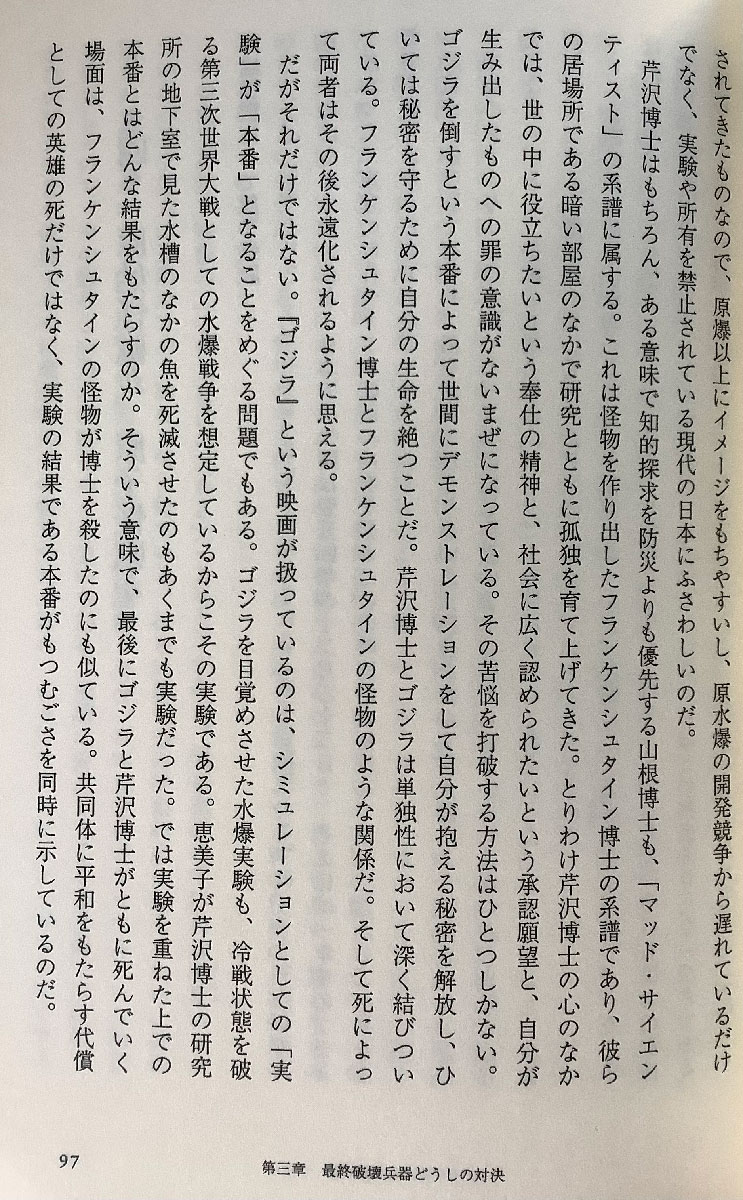4.22.2023
The Cultural History of Godzilla – Pt 38


P 96
オキシジェン・デストロイヤーは、戦争中からあった一発逆転の兵器としての原爆所有の願望を充足するとともに、たとえ個人であっても生産可能で相手に一矢を報いることができるという化学兵器の要素をもっている。しかも毒ガスなどの化学兵器なら、第一次世界大戦からドイツを中心に実用化されてきたものなので、原爆以上にイメージをもちやすいし、原水爆の開発競争から遅れているだけでなく、実験や所有を禁止されている現代の日本にふさわしいのだ。
The Oxygen Destroyer satisfies the desire of possessing an atomic bomb as a one-shot reversal weapon, which has existed since the war. Moreover, chemical weapons such as poison gas have been put into practical use since World War I, mainly in Germany. It is easier to imagine than the atomic bomb, and it is suitable for modern Japan, where not only is it behind the race to develop atomic and hydrogen bombs, but testing and possession are prohibited.

P 97
芹沢博士はもちろん、ある意味で知的探求を防災よりも優先する山根博士も、「マッド・サイエンティスト」の系譜に属する。これは怪物を作り出したフランケンシュタイン博士の系譜であり、彼らの居場所である暗い部屋のなかで研究とともに孤独を育て上げてきた。とりわけ芹沢博士の心のなかでは、世の中に役立ちたいという奉仕の精神と、社会に広く認められたいという承認願望と、自分が生み出したものへの罪の意識がないまぜになっている。その苦悩を打破する方法はひとつしかない。ゴジラを倒すという本番によって世間にデモンストレーションをして自分が抱える秘密を解放し、ひいては秘密を守るために自分の生命を絶つことだ。芹沢博士とゴジラは単独性において深く結びついている。フランケンシュタイン博士とフランケンシュタインの怪物のような関係だ。そして死によって両者はその後永遠化されるように思える。
Not only Dr. Serizawa, but also Dr. Yamane, who in a sense prioritizes intellectual pursuits over disaster prevention, belongs to the lineage of “mad scientists.” This is the genealogy of Dr. Frankenstein, who created the monsters, and has cultivated loneliness with research in the dark room where they belong. Especially in Dr. Serizawa’s heart, the spirit of service that wants to be useful to the world, the desire to be widely recognized by society, and the guilt of what he has created are mixed. There is only one way to overcome his suffering. Demonstrate to the world by defeating Godzilla, release the secret you hold, and end your own life to protect the secret. Dr. Serizawa and Godzilla are deeply connected in their singularity. It’s like Dr. Frankenstein and Frankenstein’s monster. And death seems to make them both eternal afterwards.
だがそれだけではない。「ゴジラ」という映画が扱っているのは、シミュレーションとしての「実験」が「本番」となることをめぐる問題でもある。ゴジラを目覚めさせた水爆実験も、冷戦状態を破第三次世界大戦としての水爆戦争を想定しているからこその実験である。恵美子が芹沢博士の研究所の地下室で見た水槽のなかの魚を死滅させたのもあくまでも実験だった。では実験を重ねた上での本番とはどんな結果をもたらすのか。そういう意味で、最後にゴジラと芹沢博士がともに死んでいく場面は、フランケンシュタインの怪物が博士を殺したのにも似ている。共同体に平和をもたらす代償としての英雄の死だけではなく、実験の結果である本番がもつむごさを同時に示しているのだ。
But that’s not all. What the movie “Godzilla” deals with is also the problem of turning an “experiment” as a simulation into a “real thing.” The hydrogen bomb test that awakened Godzilla is also an experiment because it assumes a hydrogen bomb war as World War III to break the Cold War state. Emiko killing the fish in the tank she saw in the basement of Dr. Serizawa’s laboratory was also an experiment. Then, what kind of results will the actual production bring after repeated experiments? In that sense, the final scene where Godzilla and Dr. Serizawa both die is similar to Frankenstein’s monster killing the doctor. It shows not only the hero’s death as a price to bring peace to the community, but also the cruelty of the actual result of the experiment.